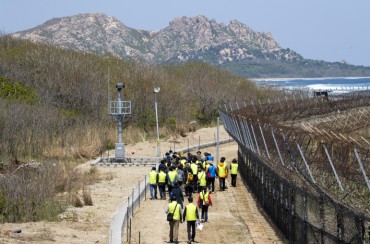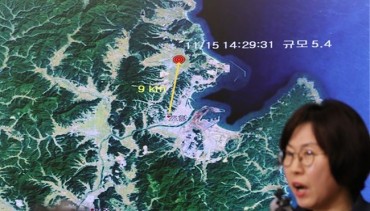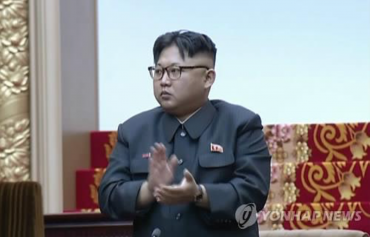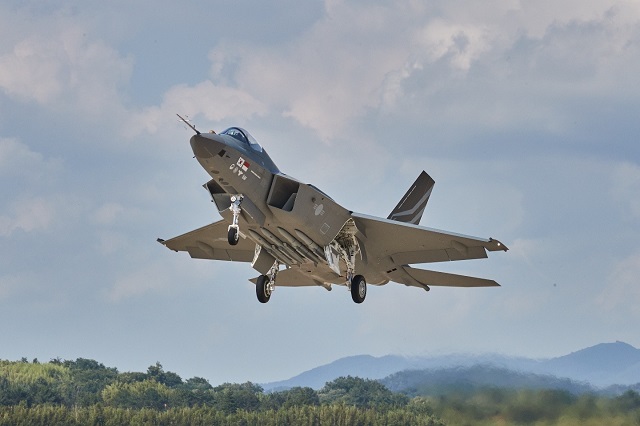
South Korea’s homegrown KF-21 fighter jet flies during its first test flight over the Air Force’s 3rd Flying Training Wing base in Sacheon, about 300 kilometers south of Seoul, on July 19, 2022, in this photo provided by the Defense Acquisition Program Administration.
SEOUL, July 19 (Korea Bizwire) — South Korea’s homegrown KF-21 fighter successfully carried out its first flight test Tuesday, around 6 1/2 years after its mammoth development project kicked off despite skepticism over technological obstacles, cost effectiveness and other feasibility questions.
At the Air Force’s 3rd Flying Training Wing in Sacheon, about 300 kilometers south of Seoul, the warplane took off, signaling South Korea is on course to join an elite club of seven countries that have locally developed supersonic fighter jets.
The maiden flight under the 8.8 trillion-won (US$6.67 billion) project came as the nation has been pushing to replace its aging fleet of F-4 and F-5 fighters with the high-end jet and bolster its airpower to counter North Korea’s evolving nuclear and missile threats.
“This is the moment when South Korea’s capabilities to develop the high-tech 4.5-generation fighter jet came to realization with this first flight,” the state Defense Acquisition Program Administration (DAPA) said in a press release.
“As we got a step closer to the successful development of the homegrown fighter, this symbolizes a new leap in the domestic aviation technology and a rise of the strong high-tech military,” it added.
The KF-21 took off at 3:40 p.m. and landed at 4:13 p.m. for the first airborne test, according to DAPA.
President Yoon Suk-yeol touted the success, saying it is “a feat for the country’s pursuit of self-defense,” his office said.
Yoon also said it “laid the groundwork for our expansion of defense exports,” praising those who have participated in the development for their hard work, it added.
The authorities had initially planned to conduct the test in the morning but delayed it by several hours due to weather conditions.
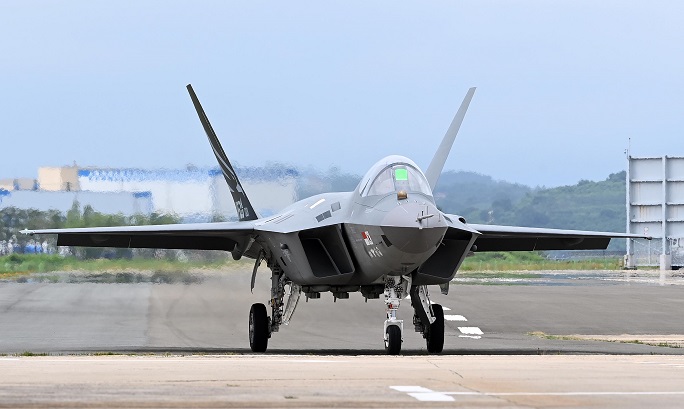
This file photo, taken July 6, 2022, shows South Korea’s homegrown KF-21 fighter jet moving on a taxiway in Sacheon, about 300 kilometers south of Seoul. (Pool photo) (Yonhap)
South Korea first envisioned the jet development project in November 2000, when then President Kim Dae-jung unveiled the nation’s hope to become an advanced fighter manufacturer by 2015 at a ceremony rolling out the KT-1 indigenous trainer aircraft.
The project took a baby step in November 2002, when the Joint Chiefs of Staff made a long-term plan to develop a high-end fighter whose capabilities go beyond the KF-16 fighter and deliver around 120 units.
But skepticism was still rampant. The two state-run agencies — the Korea Institute for Defense Analyses and the Korea Development Institute — concluded in their separate analyses in 2003 and 2007, respectively, that the project was not feasible.
However, the project got much-needed momentum in 2009, when another government-commissioned study by Konkuk University concluded the fighter development scheme was economically feasible.
The government then proceeded with an initial research process from 2011-2012 and decided in 2013 on a detailed plan for the fighter project, including the required operational capabilities and the target deployment period.
As widely anticipated, the issue of securing key fighter technologies remained a tough challenge.
The South initially sought to secure key technologies for four critical pieces of equipment — an active electronically scanned array (AESA) radar system, infrared search and track (IRST) system, electro-optical tracking pod (EO TGP) and radio frequency (RF) jammer — from the United States.
The U.S.’ answer to the request in April 2015 was negative, forcing the South to focus on domestically developing the required technologies.
Despite the technological uncertainties, DAPA signed a fighter development contract with Korea Aerospace Industries Ltd. (KAI), the country’s sole aircraft maker, in December 2015.
In the first phase of the project costing 8.1 trillion won, Indonesia participated as a partner under a deal to shoulder 20 percent of the amount.
Following the first phase to develop the overall fighter system by 2026, the second phase costing 700 billion won runs through 2028 to conduct armament tests.
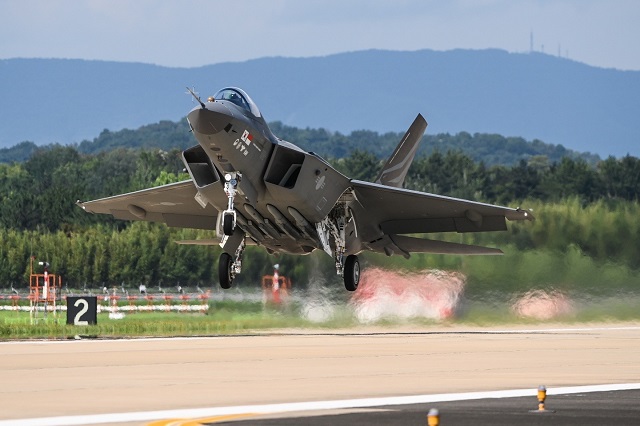
South Korea’s homegrown KF-21 fighter jet takes off during its first test flight from the Air Force’s 3rd Flying Training Wing base in Sacheon, about 300 kilometers south of Seoul, on July 19, 2022, in this photo provided by the Defense Acquisition Program Administration.
Initial skepticism over the project turned into optimism as local defense firms have successfully proceeded with the development of technologies required for the four key pieces of equipment at the core of the fighter’s battle operations.
Hanwha Systems Co. has been on track to develop the AESA radar system, with its prototype unveiled in August 2020, four years after the launch of the radar development effort.
The AESA system can detect and track multiple targets simultaneously and extensively, as the beam of radio waves is electronically steered to points in different directions without moving the antenna.
Hanwha Systems has also been in charge of developing the IRST and EO TGP. The IRST system is designed to detect and track objects that give off infrared radiation, while EO TGP is for identifying targets and guiding precision munitions like laser-guided bombs.
LIG Nex1 has been working on developing the fighter’s electronic warfare (EW) suite, including the RF jammer designed for the disruption of radio signals.
The 4.5-generation fighter will be equipped with air-to-air missiles, such as the AIM-2000 by Germany-based Diehl and the Meteor by Europe’s MBDA.
So far, five KF-21 prototypes have been rolled out for testing purposes with the sixth due out sometime this month. The prototypes are scheduled to conduct a combined 2,000 sorties or more to finish the overall fighter development by 2026.
Other than such testing procedures, the KF-21 project faces other hurdles, such as Indonesia’s overdue payments.
From 2026-2028, KAI plans to manufacture the initial units of the KF 21 Block I.
(Yonhap)



